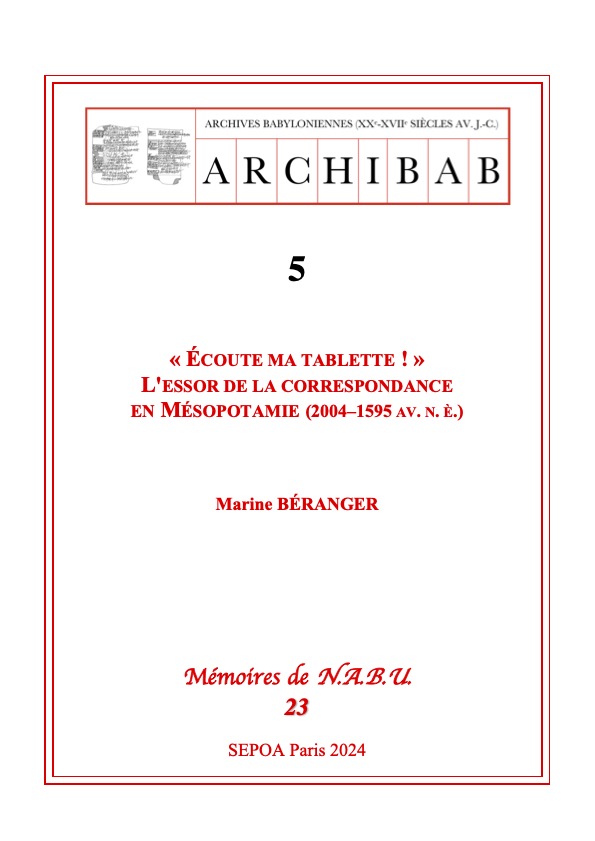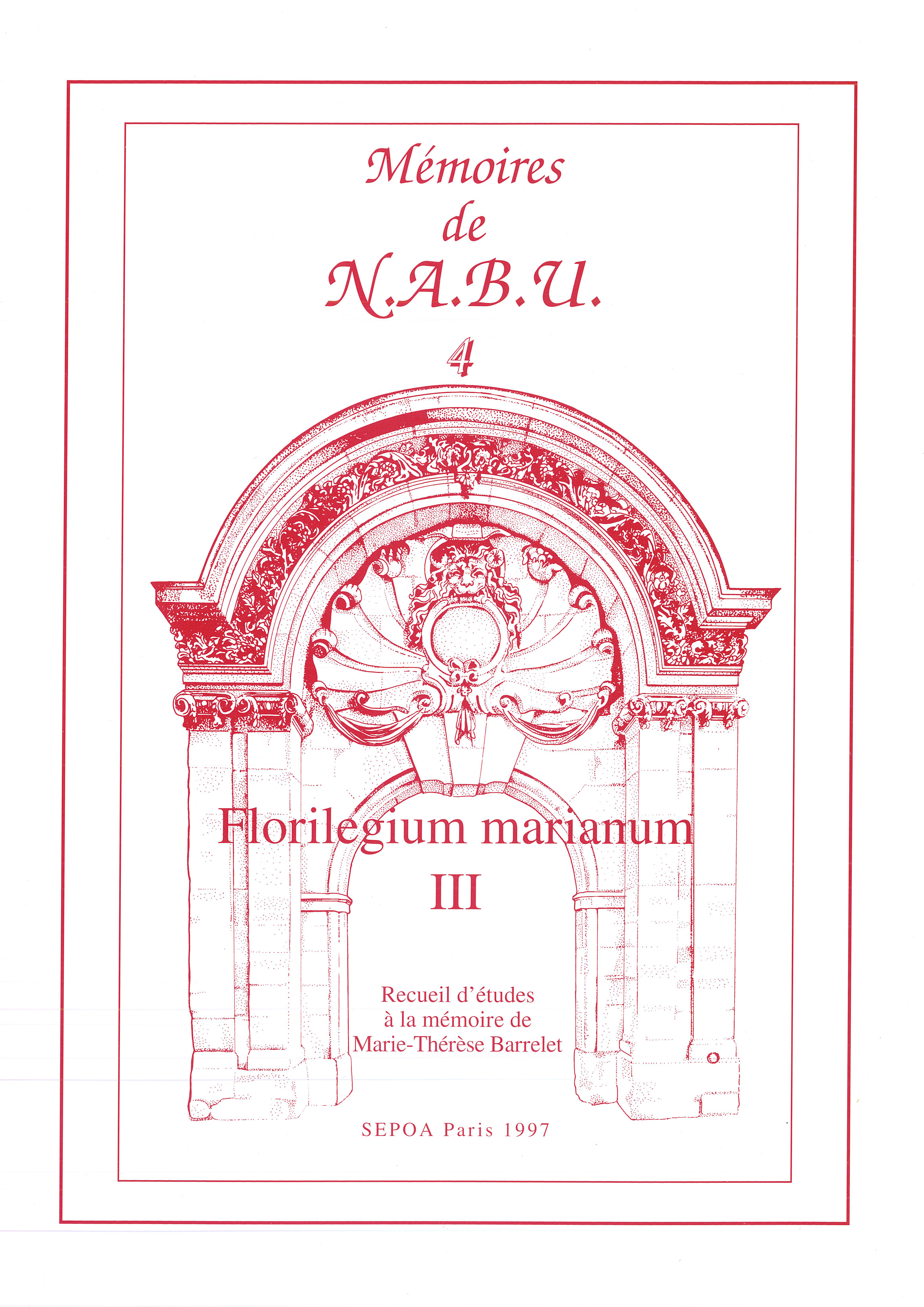Le dernier numéro de la revue NABU (2024-1) vient de paraître :
- version allégée (3 Mo) : NABU-2024-1_LITE
- version d’origine (3,4 Mo) : NABU-2024-1
Le dernier numéro de la revue NABU (2024-1) vient de paraître :

En Mésopotamie, l’écriture fut inventée et longtemps maîtrisée par un groupe restreint d’individus au service du palais et des temples. Les données archéologiques et épigraphiques témoignent d’une intensification et d’une généralisation du recours à l’écrit dans la première moitié du deuxième millénaire avant notre ère, pendant la période dite paléo-babylonienne ou amorrite (2004–1595). Il était alors devenu si courant d’envoyer des lettres que les scribes de cette époque considéraient que l’écriture avait été inventée pour communiquer à distance. Ce livre étudie l’essor de la correspondance pendant cette période. Le premier chapitre replace les lettres, qui sont en langue akkadienne, dans leur contexte social en dressant le portrait des individus qui correspondaient par écrit. Le second chapitre présente, parmi les exercices étudiés pendant le cursus scribal, ceux qui permettaient d’apprendre à lire et à écrire des lettres en akkadien. Celles copiées à l’école, en particulier, sont étudiées en détail pour la première fois. Le troisième chapitre est dédié au contenu des lettres à travers les siècles tandis que le quatrième chapitre s’inspire de la pragmatique et de la linguistique textuelle pour comparer le degré d’implicite et la complexité d’environ trois cents lettres rédigées entre le XXe et le XVIIe siècles. Cette recherche offre pour la première fois une synthèse des connaissances accumulées au cours des 130 dernières années autour d’un corpus constitué de plus de 7000 lettres paléo-babyloniennes et explore de manière innovante le contexte, le contenu et la langue de ces textes.
In Mesopotamia, writing was invented and long mastered by a small group of individuals in service to the palace and temples. Archaeological and epigraphic evidence attests to an intensification and broadening use of writing in the first half of the second millennium BC, during the so-called Old Babylonian or Amorite period (2004–1595). The exchange of letters became so commonplace that scribes of that era considered writing to have been invented for remote communication. This book explores the rise of correspondence during this period. The first chapter contextualizes the letters, written in Akkadian at the time, within their social framework by profiling the individuals who corresponded in writing. The second chapter highlights, among the scribal exercises studied during the curriculum, those that taught reading and writing letters in Akkadian. The practice letters copied in school, in particular, are examined in detail for the first time. The third chapter focuses on the content of letters throughout the centuries, while the fourth chapter draws inspiration from pragmatics and textual linguistics to compare the degree of implicitness and complexity in around three hundred letters written between the 20th and 17th centuries. This research not only offers a pioneering synthesis of knowledge gathered over the past 130 years on a corpus of over 7,000 Old Babylonian letters but also provides a fresh and innovative exploration into the context, content, and language of these letters.
Marine Béranger est docteure de l’EPHE – PSL.
Nous sommes heureux d’annoncer la publication de : Marine Béranger, Archibab 5. « Écoute ma tablette ! » L’essor de la correspondance en Mésopotamie (2004–1595 av. n. è.), Mémoires de N.A.B.U. 23, Paris, 2024.
ISBN 979-10-97449-07-0
Livre à 50€ (+ frais d’expédition)
Commande et paiement possibles sur notre boutique en ligne : 2024. Mémoires de NABU 23 (livre imprimé)

Le dernier numéro de la revue NABU (2023-4) vient de paraître :
Le dernier numéro de la revue NABU (2022-4) vient de paraître.
version d’origine (8,5 Mo) NABU 2022-4
version allégée (2,2 Mo) NABU-2022-4-LITE
SOMMAIRE NABU 2022-4
Numéro spécial : Table des matières cumulée des années 1987-2022 par N. Ziegler & A. Jacquet
136) N. Ziegler – Avant-propos
137) N. Ziegler & D. Charpin – L’histoire de la publication de NABU
138) N. Ziegler – Mistral photo – l’imprimeur de NABU
139) N. Ziegler – Le profil des auteurs des notes de NABU
140) A. Jacquet & N. Ziegler – Des notes venant des quatres rives du monde
141) A. Jacquet & N. Ziegler – Une discipline plurilingue en marche vers le Globish
142) A. Jacquet & N. Ziegler – Nabu et Tašmetum
143) N. Ziegler – Comment citer les notes de NABU
144) N. Ziegler – NABU n’en est pas à sa première fête d’anniversaire !
145) N. Ziegler – Les notes « ping pong »
146) N. Ziegler – Notes brèves ?
147) N. Ziegler – L’organisation des fascicules
148) A. Jacquet & N. Ziegler – Quelques statistiques sur le contenu des notes
149) A. Jacquet – Un nouvel outil de recherche pour NABU sur internet
150) N. Ziegler – Quelques perles
N. Ziegler & A. Jacquet, avec l’aide de Z. Földi, Table des matières cumulée des années 1987-2022
Le dernier numéro de la revue NABU (2022-2) vient de paraître. Vous pouvez le télécharger gratuitement en ligne :
SOMMAIRE NABU 2022/2
42) N. Ziegler – NABU aura 35 ans et souhaite faire un bilan sur sa vie
43) W. Sallaberger – Fara Notes, 1: Administrative lists identified as dub bar and dub gibil
44) W. Sallaberger – Fara Notes, 2: ĝiri₂ du₃ “to mark out (a field) with a dagger
45) W. Sallaberger – Fara Notes 3: Mariotes in Šuruppag
46) A. Archi – Minima Eblaitica 26: A Point of history: the Death of King Irkab-damu, and the Synchronism between the Death of two Kings of Mari and two Kings of Kakmium
47) J. Keetman – Sieben verkannte Eulen
48) J. Keetman – Die Getreidegöttin Sud
49) N. Veldhuis – A tablet from Drehem
50) S. Richardson – Polishing some Sumerian Jewels
51) A. Hussein Mohsin – The porters list, unpublished text from University of Pennsylvania Museum
52) E. Gehlken – A note on possible initial and final consonantal clusters in Sumerian words
53) N. Linder – The diri-compound SIKI.PA.IB in the Old Babylonian period
54) H. Farber – Was land in Babylonia during the reign of Hammu-rabi a good investment?
55) K. Veenhof – The redaction and interpretation of § 117-118 of the Laws of Hammurabi
56) D. Charpin – En marge d’ARCHIBAB, 36 : le prix des briques cuites à l’époque paléo-babylonienne
57) D. Charpin – En marge d’EcritUr, 21 : à propos de UET 1 275
58) M. Béranger – A Late Old Babylonian list of rations from Dur-Abi-ešuh in the Cotsen collection (Los Angeles)
59) M. Béranger – ‘Open the Granary!’ Ur-Zababa’s Letter to Ṣilli-Šamaš: The Duplicate from the Cotsen Collection
60) B. Mahieu – The Sealand I comprising two lines of 184 years each, with the conquest of Babylon 35 years before its end
61) J. Tavernier – Elamite hutli/hutliš
62) N. Kircil – Middle Hittite Period Tablets: Some Opinions on the KBo 32.114(+)KBo 32.106
63) V. Pisaniello – For an explanation of a peculiar Hittite list of body parts
64) N. A. Corfù – A Kurigalzu Brick Inscription
65) J. Beltz – The Son of King Kurigalzu on a Kassite Prayer Seal
66) K. Isik, B. Genç & R. Kuvanç – An Unpublished Urartian Inscription from Aznavurtepe Temple
67) S. Merlin – Remarques sur la détermination du nom entre lycien et grec d’Asie Mineure
68) M. Ossendrijver – On the unit UŠ = šuššān
69) S. Bojowald – Die Flut und das Vieh im Akkadischen und Ägyptischen
70) N. N. May – Nabû-zuqup-kēnu and Indication of Place of Writing in Neo-Assyrian Colophons
71) A. Elayi & J. Elayi – Sennacherib’s choice of circular/elliptical military camps
72) M. Karlsson – Not one of us (any more): from Nabû-šēzibanni to Pišamelki
73) M. Karlsson – Pabaku: A New Egyptian Name in Cuneiform?
74) M. Jursa –Nabopolassar auditing Eanna’s practice of disbursing barley to prebendary bakers
75) D. Charpin – Une pique de Scheil contre « certain “terrassier” »
76) J. Oelsner – Zu Joachim Oelsner, Der Kodex Ḫammu-rāpi. Textkritische Ausgabe und Übersetzung, Münster 2022 (dubsar 4)
Le dernier numéro de la revue NABU (2022-1) vient de paraître. Vous pouvez le télécharger gratuitement en ligne :
SOMMAIRE NABU 2022/1
1) The location of Umm Chatil: a note on BM 116618 – C. Johansson & R. Rattenborg
2) Observations on ŠÁM and KI in the archaic text corpus* – E. Gehlken
3) Éblaïte gú-a-tum : un bilan provisoire – J. Pasquali
4) Ad Suter 20181) – another instance of early ekphrasis – J. Bach
5) Vocabula sumerica 1. UGU – A. Cavigneaux
6) Vocabula sumerica 2. ZAL et le temps qui fond – A. Cavigneaux
7) Vocabula sumerica 3. su/sù(-g), marû su-su/sù-sù – A. Cavigneaux
8) Vocabula sumerica 4. TE = écarter, éloigner ? – A. Cavigneaux
9) Beth Shean 3?: A Sumerian Royal Inscription revealed in Nehemia Zori’s Archaeological – W. Horowitz, Z. Greenhut & A. Cohen-Weinberger
10) Lubanda, governor of Irisaĝrig – F. Pomponio
11) A note on early sceptres* – A. Johandi
12) Some notes on the god Ensigalabzu* – A. Johandi
13) Beobachtungen zum Aufbau der Zame Hymnen – J. Keetman
14) Another Sumerian model contract – K. Wagensonner
15) The list Lugal-me, some preliminary notes – K. Wagensonner
16) Pī Mūti: A Ugaritism in the Hymn to Marduk from Ugarit? – N. Ayali-Darshan
17) A cognate for Akk. ḫabāqu? – W. G. E. Watson
18) Hittite dāri(ya)nu– ‘to weary; to importune’ – H. C. Melchert
19) Elamite tap – J. Tavernier
20) BM 99128 (A.0.100.7) – Tukulti-Ninurta II or Aššur-reš-iši? – J. McGinnis
21) A Fish? A Bird? – A New Interpretation of the Drawing on VAT 13141 – E. Zomer
22) RI-ma-ŠU/RI-ma-a-MU in Ludlul Bēl Nēmeqi I, line 19 – T. M. Oshima
23) Das Klagen der Eule in der akkadischen und ägyptischen Sprache – S. Bojowald
24) Zu einer akkadisch-ägyptischen Parallele bei der übertragenen Verwendung von Verben für „gehen“ im Sinne „Vögel fliegen – S. Bojowald
25) Eine ägyptisch-akkadische Parallele hinsichtlich der Vorstellung von Soldaten als Frauen – S. Bojowald
26) GIM, “as above”, an intertextual reference in the Great Star List used as an editorial note in the colophon of the diagnostic omen series SA.GIG – J. C. Fincke
27) Ḫapi-maniḫi: A new Egyptian name in cuneiform? – M. Karlsson
28) Assyrian-style dress in the Levant: Examples from Sidon and Salamis – A. A. Baaklini
29) Prisme d’Assurbanipal du type G – un fragment complémentaire au Louvre – J. Maniaczyk
30) Mouvements comptables dans l’Eanna d’Uruk – Fr. Joannès
31) Babylonian Miscellanea 1. The date of construction of the Euphrates Canal (Nār-Puratti) – S. Zawadzki
32) Babylonian Miscellanea 2. An additional text from the Balīḫû archive* – S. Zawadzki
33) Babylonian Miscellanea 3. Blacksmithing as a family profession – S. Zawadzki
34) Babylonian Miscellanea 4. The year of death of Itti-Marduk-balāṭup one more – S. Zawadzki
35) Babylonian Miscellanea 5. Tablets and envelopes in the Neo-Babylonian periods: some notes on the margin of diplomatics in the first millennium BC – S. Zawadzki
36) Babylonian Miscellanea 6. The Sun-God Tablet and its(?) clay impressions – S. Zawadzki
37) Arameo-Akkadica III1) – R. Zadok
38) NB/LB Onomastic and lexical notes – R. Zadok
39) “Chaldean” as kalû? – S. Helle
40) Die „qualitativ bewertete Zeit“ – das gesamte Narrativ – T. Janssen
41) Cuneiform Tablets from Various Auctions – Part III: The Second and First Millennium B. C. – C. Theis
Le dernier numéro de la revue NABU (2021-4) vient de paraître. Vous pouvez le télécharger gratuitement en ligne :
version allégée (6,2 Mo) : NABU 2021-4 (light)
version d’origine (7 Mo) : NABU 2021-4
